mistakenly believe that they are in the fly’s
so much that it can’t make proteins? Then the
thorax, and therefore ought to grow into a leg.
bacterium won’t grow, and Green wouldn’t find it.
And so they do.
Using clever molecular tricks, Green figured
Thinking about this odd situation taught
out a way to rescue some of the bacteria with
scientists an important lesson—that the proteins
defective ribosomes so they could grow. While
made by some genes can act as switches. Switch
some of the rescued bacteria have changes in
genes are master controllers that provide each
their ribosomal RNA that make them resistant
body part with a kind of identification card. If a
to certain antibiotics (and thus would not make
protein that normally instructs cells to become
good antibiotic targets) other RNA changes that
an antenna is disrupted, cells can receive new
don’t affect resistance may point to promising
instructions to become a leg instead.
ideas for new antibiotics.
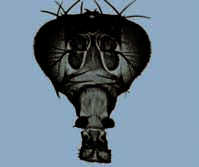
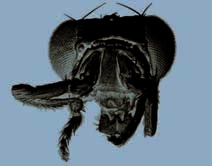
The New Genetics I How Genes Work 21
FLYBASE; R. TURNER
. Normal fruit fly head.
. Fruit fly head showing the effects of the Antennapedia gene. This fly has legs where its antennae should be.
Scientists determined that several different
genes of different organisms, it’s a good clue
genes, each with a common sequence, provide
that these genes do something so important and
these anatomical identification card instructions.
useful that evolution uses the same sequence
Kaufman isolated and described one of these
over and over and permits very few changes in
genes, which became known as Antennapedia,
its structure as new species evolve.
a word that means “antenna feet.”
Researchers quickly discovered nearly
Kaufman then began looking a lot more
identical versions of homeobox DNA in almost
closely at the molecular structure of the
every nonbacterial cell they examined—from
Antennapedia gene. In the early 1980s, he and
yeast to plants, frogs, worms, beetles, chickens,
other researchers made a discovery that has been
mice and people.
fundamental to understanding evolution as well
Hundreds of homeoboxcontaining genes
as developmental biology.
have been identified, and the proteins they
The scientists found a short sequence of DNA,
make turn out to be involved in the early stages
now called the homeobox, that is present not only
of development of many species. For example,
in Antennapedia but in the several genes next to
researchers have found that abnormalities in
it and in genes in many other organisms. When
the homeobox genes can lead to extra fingers or
geneticists find very similar DNA sequences in the
toes in humans.
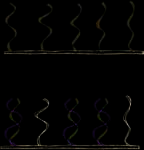

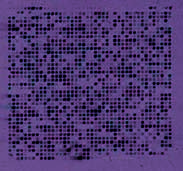
22 National Institute of General Medical Sciences The Tools of Genetics: Mighty Microarrays We now have the ability to attach a piece of every
but teachers and students are using them, too.
gene in a genome (all of an organism’s genes) to
The Genome Consortium for Active Teaching
a postage stampsized glass microscope slide.
program (www.bio.davidson.edu/GCAT) pro
This ordered series of DNA spots is called a DNA
vides resources and instructions for high school
microarray, a gene chip or a DNA chip.
and college students to do genechip experiments
Whichever name you prefer, the chip could
in class.
also be called revolutionary. This technology has
Microarrays are used to get clues about
changed the way many geneticists do their work
which genes are expressed to control cell, tissue
by making it possible to observe the activity of
or organ function. By measuring the level of RNA
thousands of genes at once.
production for every gene at the same time,
In recent years, microarrays have become
researchers can learn the genetic programming
standard equipment for modern biologists,
that makes cell types different and diseased cells
different from healthy ones.
The chips consist of large numbers of DNA
fragments distributed in rows in a very small
space. The arrays are laid out by robots that can
DNA fragments
DNA fragments are attached to
T The resulting pattern of fluorescence indicates
glass or plastic, then fluorescently
which genes are active.
tagged molecules are washed over
the fragments.
Complementary mRNA
Some molecules (green) bind to their
complementary sequence. These molecules can be identified because they glow under fluorescent light.
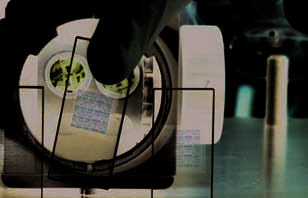
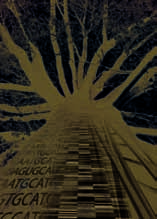
Got It?
Why are some infections hard
to treat with antibiotics? What
are some things researchers
might do to solve this public
health problem?
How does DNA work as a form
position DNA fragments so precisely that
In December 2004, the U.S. Food and
of information storage?
more than 20,000 of them can fit on one micro
Drug Administration cleared the first
scope slide.
gene chip for medical use. The Amplichip
Scientists isolate mRNA from cells grown
CYP450™, made by Roche Molecular Systems
How can 20,000 human genes
under two conditions and tag the two sources
Inc. of Pleasanton, California, analyzes variaprovide the instructions for of RNA with different colors of fluorescent moletions in two genes that play a major role in making hundreds of thousands
cules. The two colors of RNA are then placed
the body’s processing of many widely preof different proteins?
on the chip, where they attach to complementary
scribed drugs. This information can help
DNA fragments anchored to the chip’s surface.
doctors choose the proper dose of certain
Next, a scanner measures the amount of
medicines for an individual patient.
What newborn tests does your
fluorescence at each spot on the chip, revealing
area hospital routinely do?
how active each gene was (how much mRNA
each gene produced). A computer analyzes the
patterns of gene activity, providing a snapshot
of a genome under two conditions ( e.g. , healthy
or diseased).

C H A P T E R 2
RNA and DNA Revealed: New Roles, New Rules For many years, when scientists thought
about heredity, DNA was the first thing
to come to mind. It’s true that DNA is the basic
ingredient of our genes and, as such, it often
steals the limelight from RNA, the other form
C
G
of genetic material inside our cells.
U
C
But, while they are both types of genetic
Sugar
U
phosphate
material, RNA and DNA are rather different.
backbone
C
The chemical units of RNA are like those of
G
A
DNA, except that RNA has the nucleotide uracil
C
(U) instead of thymine (T). Unlike double
U
stranded DNA, RNA usually comes as only a single
C
G
strand. And the nucleotides in RNA contain ribose
G
sugar molecules in place of deoxyribose.
A
U
RNA is quite flexible—unlike DNA, which is
Base
U
a rigid, spiralstaircase molecule that is very stable.
G
RNA can twist itself into a variety of complicated,
C
U
threedimensional shapes. RNA is also unstable in
C
that cells constantly break it down and must continually make it fresh, while DNA is not broken C
A
down often. RNA’s instability lets cells change
G
their patterns of protein synthesis very quickly
C
A
in response to what’s going on around them.
C
Many textbooks still portray RNA as a passive
A
U
molecule, simply a “middle step” in the cell’s
� Ribonucleic acid (RNA) has
genereading activities. But that view is no longer
the bases adenine (A),
cytosine (C), guanine (G)
accurate. Each year, researchers unlock new
and uracil (U).
secrets about RNA. These discoveries reveal that
it is truly a remarkable molecule and a multi talented actor in heredity.
RNA RNA RNA RNA RNA RNA RNA RNA RNA RNA RNA RNA RNA RNA RNA RNA RNA RNA RNA RNA RNA RNA RNA RNA RNA RNA RNA
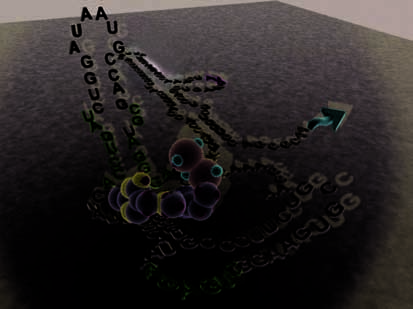
The New Genetics I RNA and DNA Revealed: New Roles, New Rules 25
Riboswitches are RNA
sequences that control
gene activity. The riboswitch
shown here bends into a
special shape when it grips
tightly onto a molecule
called a metabolite (colored
BREAKER
balls) that bacteria need
to survive.
RONALD
Today, many scientists believe that RNA
because of its ability to lead a double life: to store
evolved on the Earth long before DNA did.
information and to conduct chemical reactions.
Researchers hypothesize — obviously, no one
In other words, in this world, RNA served the
was around to write this down — that RNA was
functions of both DNA and proteins.
a major participant in the chemical reactions
What does any of this have to do with human
that ultimately spawned the first signs of life
health? Plenty, it turns out.
on the planet.
Today’s researchers are harnessing some of
RNA’s flexibility and power. For example, through
RNA World
a strategy he calls directed evolution, molecular
At least two basic requirements exist for making
engineer Ronald R. Breaker of Yale University is
a cell: the ability to hook molecules together and
developing ways to create entirely new forms of
break them apart, and the ability to replicate, or
RNA and DNA that both work as enzymes.
copy itself, from existing information.
Breaker and others have also uncovered
RNA probably helped to form the first cell.
a hidden world of RNAs that play a major
The first organic molecules, meaning molecules
role in controlling gene activity, a job once
containing carbon, most likely arose out of random
thought to be performed exclusively by proteins.
collisions of gases in the Earth’s primitive atmos
These RNAs, which the scientists named
phere, energy from the Sun, and heat from naturally
riboswitches, are found in a wide variety of
occurring radioactivity. Some scientists think that
bacteria and other organisms.
in this primitive world, RNA was a critical molecule
RNA RNA RNA RNA RNA RNA RNA RNA RNA RNA RNA RNA RNA RNA RNA RNA RNA RNA RNA RNA RNA RNA RNA RNA RNA RNA RNA
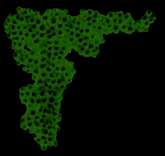
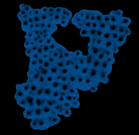

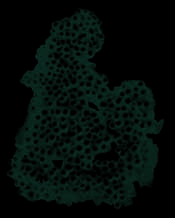
26 National Institute of General Medical Sciences This discovery has led Breaker to speculate
that new kinds of antibiotic medicines could be
developed to target bacterial riboswitches.
Molecular Editor
Scientists are learning of another way to customize proteins: by RNA editing. Although DNA sequences spell out instructions for producing
RNA comes in a variety of
different shapes (above
RNA and proteins, these instructions aren’t
and right).
always followed precisely. Editing
a gene’s mRNA, even by a single
chemical letter, can radically change
Doublestranded DNA
the resulting protein’s function.
(left) is a staircaselike
molecule.
Nature likely evolved the RNA
editing function as a way to get more
proteins out of the same number of
Small But Powerful
Recently, molecules called microRNAs have been
found in organisms as diverse as plants, worms
Larger RNA
and people. The molecules are truly “micro,” consisting of only a few dozen nucleotides, compared to typical human mRNAs that are a few thousand
nucleotides long.
Dicer
enzyme
What’s
particularly interesting about microRNAs
is that many of them arise from DNA that used
to be considered merely filler material (see
MicroRNA
page 14).
How do these small but important RNA molecules do their work? They start out much bigger but get trimmed by cellular enzymes, including
mRNA
one aptly named Dicer. Like tiny pieces of
Nearperfect complementarity
to target mRNA
The enzyme Dicer generates microRNAs by
chopping larger RNA molecules into tiny
No translation
Velcro®like pieces. MicroRNAs stick to mRNA
molecules and prevent the mRNAs from being
made into proteins.
No protein
RNA RNA RNA RNA RNA RNA RNA RNA RNA RNA RNA RNA RNA RNA RNA RNA RNA RNA RNA RNA RNA RNA RNA RNA RNA RNA RNA
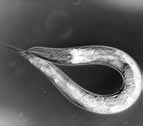
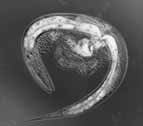
The New Genetics I RNA and DNA Revealed: New Roles, New Rules 27
genes. For example, researchers have found that
the RNA sequence, which in turn changes the
the mRNAs for certain proteins important for the
protein that gets made.
proper functioning of the nervous system are
Bass’ experiments show that RNA editing
particularly prone to editing. It may be that RNA
occurs in a variety of organisms, including peoediting gives certain brain cells the capacity to ple. Another interesting aspect of editing is that
react quickly to a changing environment.
certain diseasecausing microorganisms, such as
Which molecules serve as the editor and how
some forms of parasites, use RNA editing to gain
does this happen? Brenda Bass of the University of
a survival edge when living in a human host.
Utah School of Medicine in Salt Lake City studies
Understanding the details of this process is an
one particular class of editors called adenosine
important area of medical research.
deaminases. These enzymes “retype” RNA letters
at various places within an mRNA transcript.
They do their job by searching for characteristic RNA shapes. Telltale twists and bends in folded RNA molecules signal these enzymes to change
AM
Y
PASQUINELLI
Velcro®, microRNAs stick to certain mRNA molecules and stop them from passing on their Worms with a mutated form of the microRNA let7
proteinmaking instructions.
(right) have severe growth problems, rupturing as
First discovered in a roundworm model system
they develop.
(see Living Laboratories, page 49), some microRNAs help determine the organism’s body plan. In their
absence, very bad things can happen. For example, worms engineered to lack a microRNA called MicroRNA molecules also have been linked to
let7 develop so abnormally that they often rupture
cancer. For example, Gregory Hannon of the Cold
and practically break in half as the worm grows.
Spring Harbor Laboratory on Long Island, New
Perhaps it is not surprising that since microRNAs
York, found that certain microRNAs are associhelp specify the timing of an organism’s developated with the severity of the blood cancer Bcell mental plan, the appearance of the microRNAs
lymphoma in mice.
themselves is carefully timed inside a developing
Since the discovery of microRNAs in the
organism. Biologists, including Amy Pasquinelli
first years of the 21st century, scientists have
of the University of California, San Diego, are curidentified hundreds of them that likely exist as rently figuring out how microRNAs are made
part of a large family with similar nucleotide
and cut to size, as well as how they are produced
sequences. New roles for these molecules are
at the proper time during development.
still being found.
RNA RNA RNA RNA RNA RNA RNA RNA RNA RNA RNA RNA RNA RNA RNA RNA RNA RNA RNA RNA RNA RNA RNA RNA RNA RNA RNA 28 National Institute of General Medical Sciences RNA Interference (RNAi)
Dicer enzyme
Doublestranded RNA (dsRNA) is chopped
dsRNA
into short interfering RNAs (siRNAs) by the
enzyme Dicer.
Short interfering
RNAs (siRNAs)
A
G U A
G
U
C
C
RISC
A
G U
G
The RNAinduced silencing
U C
A C
complex (RISC) enzyme
U
C A
C
A G
U G
attaches to siRNA.
mRNA
The siRNARISC complex
attaches to target mRNA
and chops the mRNA into
small pieces.
Chopped mRNA
(no longer functional)
RNA RNA RNA RNA RNA RNA RNA RNA RNA RNA RNA RNA RNA RNA RNA RNA RNA RNA RNA RNA RNA RNA RNA RNA RNA RNA RNA

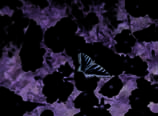
The New Genetics I RNA and DNA Revealed: New Roles, New Rules 29
Healthy Interference
RNA controls genes in a way that was only discovered recently: a process called RNA interference, or RNAi. Although scientists identified RNAi less
than 10 years ago, they now know that organisms
have been using this trick for millions of years.
Researchers believe that RNAi arose as a way to
of genes that affect cell growth and tissue
reduce the production of a gene’s encoded protein
formation in roundworms, using a molecular
for purposes of finetuning growth or selfdefense.
tool called antisense RNA.
When viruses infect cells, for example, they com
To their surprise, Mello and Fire found
mand their host to produce specialized RNAs
that their antisense RNA tool wasn’t doing
that allow the virus to survive and make copies
much at all. Rather, they determined, a doubleof itself. Researchers believe that RNAi eliminates stranded contaminant produced during the
unwanted viral RNA, and some speculate that
synthesis of the singlestranded antisense RNA
it may even play a role in human immunity.
interfered with gene expression. Mello and
Oddly enough, scientists discovered RNAi
Fire named the process RNAi, and in 2006 were
from a failed experiment! Researchers investiawarded the Nobel Prize in physiology or gating genes involved in plant growth noticed
medicine for their discovery.
something strange: When they tried to turn
Further experiments revealed that the doublepetunia flowers purple by adding an extra stranded RNA gets chopped up inside the cell
“purple” gene, the flowers bloomed white instead.
into much smaller pieces that stick to mRNA and
This result fascinated researchers, who could
block its action, much like the microRNA pieces
not understand how adding genetic material
of Velcro discussed above (see drawing, page 28).
could somehow get rid of an inherited trait. The
Today, scientists are taking a cue from nature
mystery remained unsolved until, a few years
and using RNAi to explore biology. They have
later, two geneticists studying development saw
learned, for example, that the process is not limited
a similar thing happening in lab animals.
to worms




















